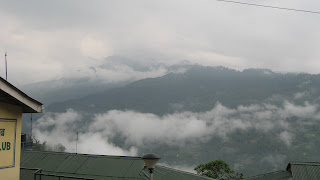Journey to Gangtok, capital of Sikkim is like
visit to a place of spirituality . Gangtok is the capital and largest town of the Indian state
of Sikkim. Gangtok is
located in the eastern Himalayan range, at an altitude of 5,800 feet (1,800 m). The
town, with a population of one lakh, ninety thousand belonging to different
ethnicities such as Indian-Nepalis, Lepchas and Bhutia, is administered by the "Gangtok Municipal
Corporation". Nestled within higher peaks of the Himalaya and enjoying a
year-round mild temperate climate, Gangtok is at the centre of Sikkim’s tourism
industry.
Gangtok
rose to prominence as a popular Buddhist pilgrimage
site after the construction of the Enchey Monastery in
1840. In 1894, the ruling Sikkimese Chogyal, Thutob Namgyal,
transferred the capital to Gangtok. In the early 20th century, Gangtok became a
major stopover on the trade route between Lhasa in Tibet and cities such
as Kolkata (then
Calcutta) inBritish India. After India won its independence
from Britain in 1947, Sikkim chose to remain an independent monarchy, with
Gangtok as its capital. In 1975, after the integration with the union of India,
Gangtok was made India's twenty-second state capital.
The
precise meaning of the name Gangtok is unclear, though the
most popular meaning is "hill top". Today, Gangtok is a centre
of Tibetan Buddhist culture and learning, with the presence of several
monasteries, religious educational institutions, and centres for Tibetology.
Like the rest of Sikkim, not much is known about the early history
of Gangtok. The earliest records date from the construction of the hermitic Gangtok
monastery in 1716. Gangtok remained a small hamlet until the construction
of the Enchey Monastery in 1840 made it a
pilgrimage center. It became the capital of what was left of Sikkim after an
English conquest in mid 19th century in response to a hostage crisis. After
the defeat of the Tibetans by the British,
Gangtok became a major stopover in the trade between Tibet and British India at
the end of the 19th century. Most of the roads and the telegraph in
the area were built during this time.
Gangtok City
In 1894, Thutob Namgyal, the Sikkimese monarch under
British rule, shifted the capital from Tumlong to
Gangtok, increasing the city's importance. A new grand palace along with other
state buildings was built in the new capital. Following India's independence in 1947, Sikkim
became a nation-state with Gangtok as its capital. Sikkim came
under the suzerainty of India, with the condition that it would
retain its independence, by the treaty signed between the Chogyal and
the then Indian Prime Minister Jawaharlal Nehru.This
pact gave the Indians control of external affairs on behalf of Sikkimese. Trade
between India and Tibet continued to flourish through the Nathula and Jelepla passes,
offshoots of the ancient Silk Road near Gangtok. These border passes were sealed after
the Sino-Indian War in 1962, which deprived
Gangtok of its trading business.The Nathula pass was finally opened for limited
trade in 2006, fuelling hopes of economic boom.
In 1975, after years of political uncertainty and struggle,
including riots, the monarchy was abrogated and Sikkim became India's
twenty-second state, with Gangtok as its capital after a referendum. Gangtok
has witnessed annual landslides, resulting in loss of life and damage to
property. The largest disaster occurred in June 1997, when 38 were killed and
hundreds of buildings were destroyed.


कोई टिप्पणी नहीं:
एक टिप्पणी भेजें